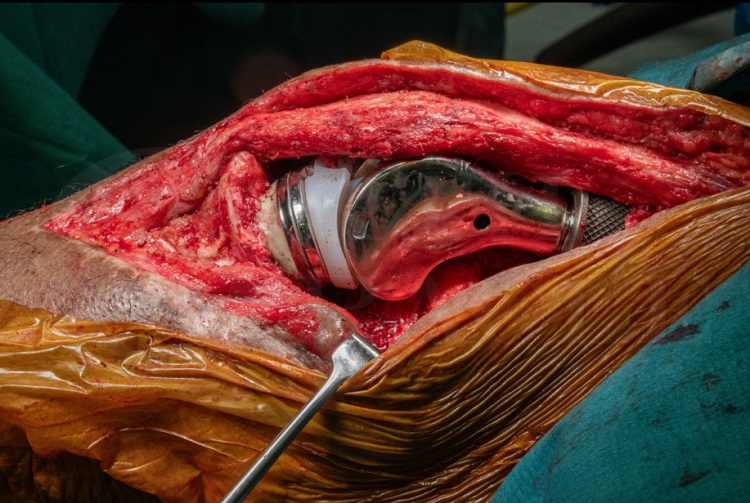Übersetzt aus dem Englischen:
Lernen Sie die chirurgische Technik zur Revision der totalen Knieendoprothese: Zweite Stufe unter Verwendung des Adler Pantheon-Ersatzes mit Rekonstruktion des Gastrocnemius-Lappens mit schrittweisen Anweisungen auf OrthOracle. Unsere E-Learning-Plattform enthält hochauflösende Bilder und eine zertifizierte Fortbildung (CME) des chirurgischen Verfahrens zur Revision der totalen Knieendoprothese: Zweite Stufe unter Verwendung des Adler Pantheon-Ersatzes mit Rekonstruktion des Gastrocnemius-Lappens.
Die Anzahl der primären und revidierten Knieendoprothesen steigt stetig, was zwangsläufig zu mehr Protheseninfektionen führt, die von spezialisierten multidisziplinären Teams für Protheseninfektionen behandelt werden. Infektionen sind eine verheerende Komplikation der totalen Gelenkendoprothetik und nicht nur die häufigste Ursache für frühzeitiges Versagen von Gelenkersatzoperationen, sondern auch die häufigste Ursache für das Versagen von revisionsbedürftigen Knieendoprothesen zu jedem Zeitpunkt.
Dass Protheseninfektionen mit einer höheren Sterblichkeitsrate verbunden sind als einige häufige Krebserkrankungen, wurde weit verbreitet berichtet. Die Fünfjahresüberlebensrate nach einer Protheseninfektion beträgt 78% im Vergleich zu 90% bei Patienten, die sich einer aseptischen Revisionsendoprothetik unterziehen (Matar H, et al. Septic Revision Total Knee Arthroplasty Is Associated With Significantly Higher Mortality Than Aseptic Revisions: Long-Term Single-Center Study (1254 Patients). Journal of Arthroplasty 2021).
Original Intro:
Revision total knee replacement: Second stage using Adler Pantheon replacement with gastrocnemius flap reconstruction
Learn the Revision total knee replacement: Second stage using Adler Pantheon replacement with gastrocnemius flap reconstruction surgical technique with step by step instructions on OrthOracle. Our e-learning platform contains high resolution images and a certified CME of the Revision total knee replacement: Second stage using Adler Pantheon replacement with gastrocnemius flap reconstruction surgical procedure.
Increasing numbers of primary and revision knee replacements are being performed which inevitably lead to more prosthetic joint infections (PJI) presenting to specialist PJI multi-disciplinary teams. Infection is a devastating complication of total joint arthroplasty and not only the most common cause for early failure of joint replacements but also the most common cause for failure of revision knee replacements at any time.
That PJI is associated with higher mortality than some common malignancies has been widely reported. The five year survival after PJI is 78% compared to 90% in patients undergoing aseptic revision arthroplasty (Matar H, et al. Septic Revision Total Knee Arthroplasty Is Associated With Significantly Higher Mortality Than Aseptic Revisions: Long-Term Single-Center Study (1254 Patients). Journal of Arthroplasty 2021).
The treatment of prosthetic joint infection typically requires surgery involving explant of the infected prosthesis, radical debridement and then either immediate reimplantation or use of an antibiotic loaded cement spacer and delayed reimplantation (a two-stage revision, as in this case). Alternative strategies include debridement and implant retention with modular exchange (indicated in acute PJI) and single-stage revision (considered in infected primary arthroplasty implants, sensitive organisms and without soft-tissue defects requiring plastic surgery). There is endless debate about selecting the correct option for each case, the decision is multi-factorial and probably best decided in specialist PJI multi-disciplinary meetings.
Infected revision knee replacements are increasing in prevalence due to the increasing numbers of revision joint replacements being performed for septic and aseptic indications such that a 7.5-fold increase in re-revision knee replacements due to infection that has been experienced in the UK since 2005 (Lenguerrand et al. Description of the rates, trends and surgical burden associated with revision for prosthetic joint infection following primary and revision knee replacements in England and Wales: an analysis of the National Joint Registry for England, Wales, Northern Ireland and the Isle of Man.
Here I present a challenging case of reconstruction of an infected revision knee replacement, which underwent a two-stage revision using a porous tibial cone for severe bone loss and a silver-coated endoprosthetic replacement to manage segmental bone loss.
Readers will also find the following related OrthOracle surgical techniques of interest:
Second Stage Revision Total Knee Replacement. PFC / MBT TKA with metaphyseal sleeve and stem (Depuy)
Revision total Knee Replacement: Legion CCK (Smith and Nephew)
Revision total Knee Replacement- Legion Rotating Hinge Knee ( Smith and Nephew)
Total knee replacement: First stage revision with a hinged spacer and tibial tubercle osteotomy
Author: Jonathan Stevenson FRCS (Tr & Orth)
Institution: The Royal Orthopaedic Hospital, Birmingham, UK
Clinicians should seek clarification on whether any implant demonstrated is licensed for use in their own country.








